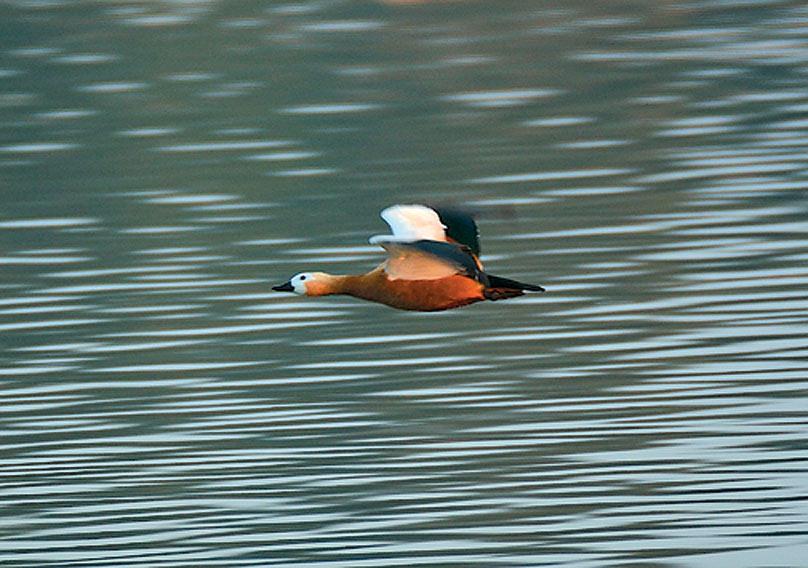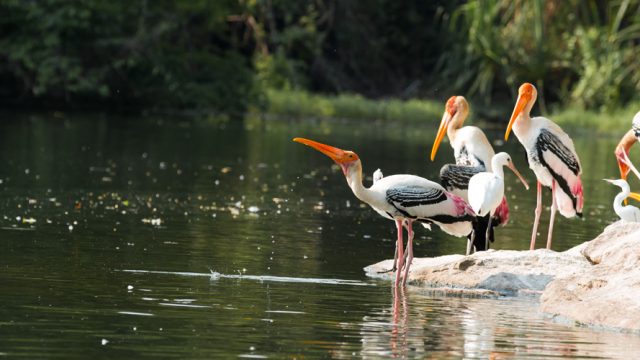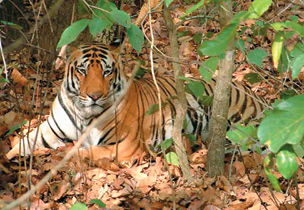When the pure white ribbon floated across the dark green forest, I was mystified. Tigers had been
That was 30 years ago, on a trip to the Corbett Tiger Reserve, one of India’s natural jewels. A year before that, I had visited the Bharatpur bird sanctuary in Rajasthan, and was already part-converted to the delights of birding. That flycatcher hooked me for good. As did the hills of what was then Uttar Pradesh, now Uttarakhand. Over many a trip since then, I have spent memorable moments watching birds of a bewildering variety.
There are some kinds of inequality nobody really minds. In harbouring well over half of India’s bird species, greater than any other state, Uttarakhand has more than its fair share of avian diversity. The latest checklist prepared by naturalists Dhananjay Mohan and Sanjay Sondhi contains 686 species, out of a total of 1,303 recorded for India. Considering that the state accounts for less than 2 per cent of India’s landmass, this is remarkable.
But it is not surprising. Uttarakhand is blessed with a dizzying range of altitude from near-sea level to several peaks over 7,000 meters high, and contains dozens of kinds of wetlands, forests, grasslands, agricultural lands and human settlements. This diversity of conditions and habitats provides food, shelter and other needs for an incredible variety of wildlife, including birds. Traditional conservationist ethics amongst many of the local communities, and official protection efforts in more modern times, have helped the state retain significant birdlife despite a number of threats. And a sign of the popularity of birdwatching as an activity was provided recently when more than 1,200 people landed up for the Uttarakhand Bird Festival at the Asan Conservation Reserve near Dehradun.
Even the most serious academics, the most radical activists, the most stiff-necked bureaucrats and the most starchy lawyers are likely to loosen up and let down their guard, should you expose them to Uttarakhand’s birdlife. How can anyone not marvel at the kaleidoscopic colours of the monal pheasant, startle at the machine gun rat-a-tat-tat of a great slaty woodpecker pecking for its food, or gasp when a Himalayan kingfisher dives deep into a river and comes out with a fish glistening in its beak?
Birding in Uttarakhand (or, well, anywhere for that matter) is the only activity that can get me out of bed at 5.30 am. Over the past year or so, I have helped the state forest department conduct three birding camps, two in the mid-hills of Nainital district, and one much higher in Pithoragarh. It is impossible to stay inside, however cold it may be, when all kinds of enticing bird calls are taking place outside. Depending on what height and in which season you’re venturing out, green magpies, Eurasian and blackheaded jays, the white-throated laughing thrush, and titmice of various kinds will be around to greet you. Downing a quick tea or nimbu-pani, you venture further out and meet a host of other species — and this could last the whole day and well into dusk, when blackbirds and whistling thrushes are still calling, and owls and nightjars take over.
Uttarakhand is good for virtually all families of birds, other than those found only in marine or desert areas. Amongst the most memorable are the woodpeckers, all 18 species of them, some smaller than a sparrow, and one (the great slaty) larger than a crow. They are also more obliging than many other birds, sitting in one place, drumming away at tree bark to prise open insects, or deepen a nesting hole. Or, and this is something I found out when a friend in Munsiyari told me to put my tongue to one of the depressions made by a woodpecker’s pecking, simply to suck at a sweet syrup the tree yields! This is the rufous-bellied woodpecker, also called, for obvious reasons, a sapsucker.
However, the pheasants, by far the most spectacular of the state’s birds, require some effort. We’re all familiar with the Indian peafowl, and some like the Kaleej and the Himalayan monal (Uttarakhand’s state bird) are relatively easy to see but no less wondrous for that reason. My first sighting of a monal near Dodital above Uttarkashi left me stunned; I could not believe the riot of colours against a metallic blue body. And if you’re prepared to climb hard, and get up before the sun is even considering ending its retirement, and wait patiently, you may be lucky enough to see its cousins, the tragopans and the cheer pheasant. All these birds are vulnerable to becoming threatened species, so do take care not to disturb them, especially in the breeding season.
Beyond the treeline, Uttarakhand’s mountain meadows and snowbound areas have their own birding charm. Finches of various kinds are delightful, though at times extremely confusing to identify. There are the choughs, reported to have followed people to the top of Sagarmatha (also known as Mt Everest). Look carefully, for you may see snowcocks, snow partridges and chukor partridges, all brilliantly camouflaged in their snowy or rocky habitat. Soaring above, griffon vultures and the lammergeier (or ‘bearded vulture’) wait patiently for prey, and the majestic golden eagle may put in an appearance. The state is, in fact, one of the best places to see these and other raptors.
Climbing to these heights, however, is not a matter of getting to a destination. Not if you’re a birder. I always take my time, even at the cost of irritating my local hosts or guides. Walking through broad-leaved forests full of oak, horse chestnut and other ancient, majestic trees, and further up through coniferous stands of pine, FIR, spruce and deodar, I have to stop to watch the myriad titmice, warblers, sunbirds, flycatchers, tree creepers, nuthatches, bulbuls, grosbeaks, yuhinas, sibias, fulvettas and (fill in a few of your own here!) that feed on or nest in them. Especially fun are the large family of laughing thrushes, always ready to cackle at your expense, some bold like the aforementioned white-throated, some a bit more reserved like the striated and the spotted. And if there are streams and rivulets on the way, I always scan the rocks and banks for forktails, looking dapper in black-and-white suits with coattails.
While the image of Uttarakhand as a land of mountains is justified, it would be a serious mistake for a birder to ignore the plains and foothills. In fact, the Uttarakhand Bird Festival was at the not-so-high Asan lake, a super place for watching water birds up close. And while this artificial reservoir is likely to have caused its own ecological damage when it was built, the natural rivers and lakes of the state are equally remarkable for their birdlife. A variety of ducks, geese, waders, storks, egrets, cormorants, herons, gulls, terns, redstarts and others make up a substantial part of the state’s checklist. Many are winter visitors, so it’s always as nice to see them turn up — like discovering the first mangoes of the season!
Forests in the foothills, including parts of the surrounds of the Corbett Tiger Reserve, are exceptional in their diversity of birds, both residents as well as local migrants that come down from the higher reaches to escape the winter cold. I have several times seen four to five species of drongos on a single walk, and often we can find a mixed flock of orioles, bulbuls, nuthatches, treepies, flycatchers, babblers, drongos and others. An unforgettable moment at Maheshkhan was when a collared owlet, India’s tiniest owl, not much bigger than a sparrow, flew in to settle on a branch a few feet in the front of me — I’m not sure which one of us was more startled!
The information
Uttarakhand birding
The festival and camps I’ve mentioned are part of a commendable initiative to promote birding by the state forest department, the brainchild of Rajiv Bhartari, the current Chief Conservator of Forests in charge of Ecotourism. In collaboration with other groups like Titli Trust, Kalpavriksh and Himal Prakriti, he has organised nearly 20 camps across the state, where over 300 forest staff, local community members, tour guides and others have learnt the basics of birding. The festival at Asan (uttarakhandbirdfestival.in) was a culmination of these gatherings, comprising guided birding, an exhibition with local groups displaying their bird-related products and birding opportunities, a lovely dance drama by the students of Kasiga and Shigally International School, choreographed by the professional dancer Sharmila Bhartari, a workshop on bird photography, and other highlights. It was such a success, the organisers immediately decided to make it an annual affair!
But even as we celebrate and enjoy Uttarakhand’s birds, they face threats from habitat destruction, hunting, pesticides, and other factors. Most worrying is the state’s dam-building spree; these structures destroy rivers, and submerge or damage forests. Haphazard urban and tourism infrastructure is another threat.
The more the state’s residents, and tourists, are made aware of these issues, and the more they become enthusiastic birders, the greater the chances of public intervention. And the more birding is linked to local livelihoods, through community-led visitation, the greater will be the public support for conservation.
Let’s hope the state’s commendable bird promotion initiative is able to achieve these aims, even as it provides us all with the opportunity to enjoy Uttarakhand as one of the country’s premier birding destinations.
Birding hotspots
There are hundreds of good birding sites in Uttarakhand and any shortlist is likely to be somewhat arbitrary. However, a good start is the recently released Uttarakhand: A Birdwatching Haven, edited by Sanjay Sondhi and produced by the state’s forest department and Titli Trust. It lists the following 20 hotspots of birding, and gives a brief glimpse of their location, features, key birds likely to be seen, and local contacts. Not all of these are official protected areas. Indeed, great birding can be done outside them too, including in areas conserved by communities such as Van Panchayats, and forests protected right from the days of the Chipko movement.
Garhwal
- Agora-Barsu-Dayara (District Uttarkashi)
- Asan-Timli (Dehradun)
- Chakrata-Koti Kanasar (Dehradun)
- Chilla-Rajaji (Dehradun and Pauri Garhwal)
- Dehradun: Thano-Maldevta-Lachhiwala (Dehradun)
- Deolsari-Magra (Tehri Garhwal)
- Govind Pashu Vihar: Har-ki-dun-Changsil-Runsara (Uttarkashi)
- Kedarnath Wildlife Sanctuary: Deoriya Taal-Chopta-Tungnath-Mandal (Chamoli, Rudraprayag)
- Khirsu (Pauri Garhwal)
- Mussoorie: Benog-Suwakholi-Dhanaulti (Dehradun, Tehri Garhwal)
Kumaon
- Binsar-Jageshwar (Almora)
- Kaladhungi-Baur (Nainital)
- Maheshkhan (Nainital)
- Marchula-Mohan-Kumeria (Ramnagar)
- Munsiyari-Askot (Pithoragarh)
- Nandhaur (Nainital, Champawat)
- Pangot-Sattal-Nainital (Nainital)
- Powalgarh-Kotabagh-Sitabani (Nainital)
- Corbett: Dhikala-Gairal (Ramnagar)
- Corbett: Jhirna-Tumeria-Phanto (Nainital and Pauri Garhwal)
For more on Uttarakhand’s birding opportunities, contact [email protected] and visit facebook.com/uttarakhandbirding.
Birding
Uttarakhand
wildlife
Leave a Reply
You must be logged in to post a comment.





